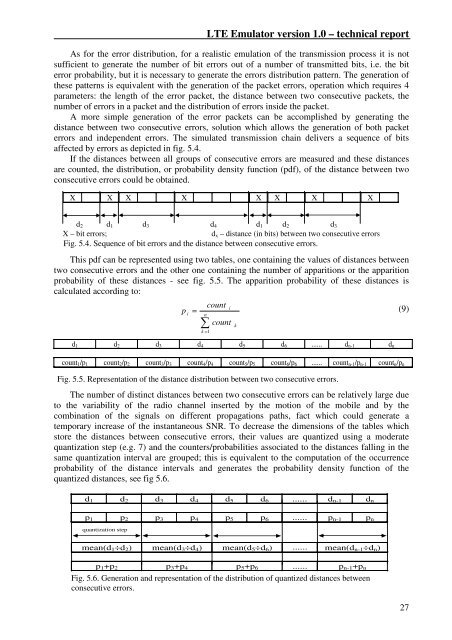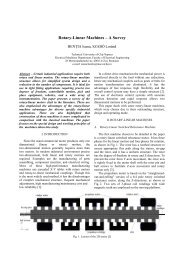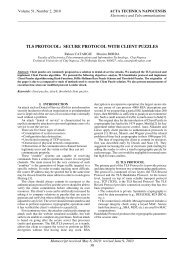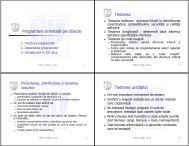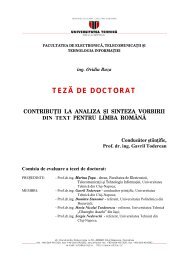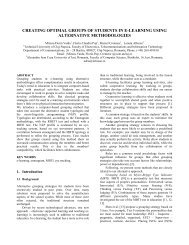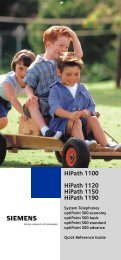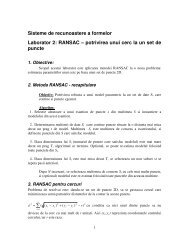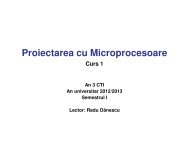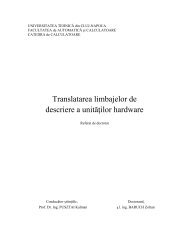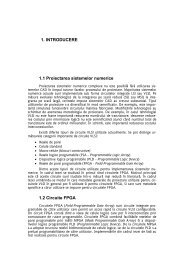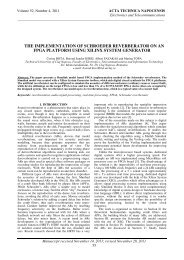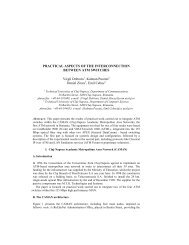LTE Emulator
LTE Emulator
LTE Emulator
You also want an ePaper? Increase the reach of your titles
YUMPU automatically turns print PDFs into web optimized ePapers that Google loves.
<strong>LTE</strong> <strong>Emulator</strong> version 1.0 – technical report<br />
As for the error distribution, for a realistic emulation of the transmission process it is not<br />
sufficient to generate the number of bit errors out of a number of transmitted bits, i.e. the bit<br />
error probability, but it is necessary to generate the errors distribution pattern. The generation of<br />
these patterns is equivalent with the generation of the packet errors, operation which requires 4<br />
parameters: the length of the error packet, the distance between two consecutive packets, the<br />
number of errors in a packet and the distribution of errors inside the packet.<br />
A more simple generation of the error packets can be accomplished by generating the<br />
distance between two consecutive errors, solution which allows the generation of both packet<br />
errors and independent errors. The simulated transmission chain delivers a sequence of bits<br />
affected by errors as depicted in fig. 5.4.<br />
If the distances between all groups of consecutive errors are measured and these distances<br />
are counted, the distribution, or probability density function (pdf), of the distance between two<br />
consecutive errors could be obtained.<br />
X X X X X X X X<br />
d2 d1 d3 d4 d1 d2 d3<br />
X – bit errors; dx – distance (in bits) between two consecutive errors<br />
Fig. 5.4. Sequence of bit errors and the distance between consecutive errors.<br />
This pdf can be represented using two tables, one containing the values of distances between<br />
two consecutive errors and the other one containing the number of apparitions or the apparition<br />
probability of these distances - see fig. 5.5. The apparition probability of these distances is<br />
calculated according to:<br />
p<br />
i<br />
= n<br />
∑<br />
k = 1<br />
count<br />
i<br />
count<br />
d1 d2 d3 d4 d5 d6 ...... dn-1 dn<br />
count1/p1 count2/p2 count3/p3 count4/p4 count5/p5 count6/p6 ...... countn-1/pn-1 countn/pn<br />
Fig. 5.5. Representation of the distance distribution between two consecutive errors.<br />
The number of distinct distances between two consecutive errors can be relatively large due<br />
to the variability of the radio channel inserted by the motion of the mobile and by the<br />
combination of the signals on different propagations paths, fact which could generate a<br />
temporary increase of the instantaneous SNR. To decrease the dimensions of the tables which<br />
store the distances between consecutive errors, their values are quantized using a moderate<br />
quantization step (e.g. 7) and the counters/probabilities associated to the distances falling in the<br />
same quantization interval are grouped; this is equivalent to the computation of the occurrence<br />
probability of the distance intervals and generates the probability density function of the<br />
quantized distances, see fig 5.6.<br />
d1 d2 d3 d4 d5 d6 ...... dn-1 dn<br />
p1 p2 p3 p4 p5 p6 ...... pn-1 pn<br />
quantization step<br />
mean(d1÷d2) mean(d3÷d4) mean(d5÷d6) ...... mean(dn-1÷dn)<br />
p1+p2 p3+p4 p5+p6 ...... pn-1+pn<br />
Fig. 5.6. Generation and representation of the distribution of quantized distances between<br />
consecutive errors.<br />
k<br />
(9)<br />
27


